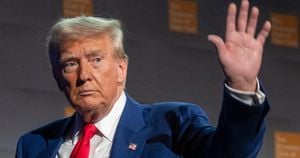New York City is on the cusp of making history as it prepares to implement its long-debated congestion pricing plan starting January 5, 2025. This initiative marks the city as the first major U.S. metropolis to adopt such a tolling structure aimed at reducing traffic congestion and generating substantial funds for public transit improvements.
Governor Kathy Hochul announced the revised congestion pricing scheme on November 14, emphasizing its dual purpose: to alleviate Manhattan's notorious gridlock and to provide the Metropolitan Transportation Authority (MTA) with approximately $15 billion for necessary upgrades and repairs.
The mayor’s initial proposal for the congestion toll was set at $15. After much backlash and scrutiny from various stakeholders, the toll has been reduced to $9 during peak hours for passenger vehicles. This price cut reflects Hochul's acknowledgment of rising costs of living and her commitment to making public transit funding more manageable for everyday commuters.
“I’m proud to announce we have found a path to fund the MTA, reduce congestion and keep millions of dollars in the pockets of our commuters,” stated Hochul. The price drop has been met with mixed reactions, with some applauding the relief it provides to drivers, and others raising concerns about the long-term effects on traffic and delivery services across the city.
Under the new pricing model, the toll structure will vary depending on the type of vehicle, time of day, and whether drivers are using E-ZPass. For passenger vehicles paying with E-ZPass, the toll during peak hours will be $9, whereas those lacking E-ZPass will incur fees of around $13.50. Off-peak rates will significantly drop to $2.25 for E-ZPass users, representing a considerable 75% decrease compared to the daytime rate.
Larger vehicles will face steeper charges; large trucks will pay as much as $21.60 during peak hours, down from the originally proposed $36. Motorcycles will benefit with only $4.50 charged during the day. Ride-sharing services are also impacted, with app-based rides like Uber and Lyft incurring additional surcharges of $1.50, and traditional taxis facing $0.75 fees for entry.
The MTA has aimed to balance the need for revenue with the current economic climate, emphasizing financial support for low-income drivers. Vehicle owners making under $50,000 annually can qualify for discounts after their 10th toll of the month, reducing the rate by 50%. They can also gain additional credits for using specific arteries like the Lincoln or Holland tunnels.
With the official start of tolling just weeks away, the congestion pricing program has been subject to intense scrutiny. Just months ago, Hochul paused the rollout of the program amid fears it would lead to excessive costs for drivers. Critics have long debated the potential economic impact on local restaurants and businesses, fearing the extra tolls might deter customers and complicate deliveries.
"Businesses are worried about the extra cost of deliveries, reducing foot traffic," said one local restaurant owner. This concern is compounded by the lack of guaranteed discounts for delivery trucks, intensifying apprehension about long-term operational viability.
Hochul's vision does not stop with just implementing the pricing scheme; she has also vowed to improve city transit services, announcing enhancements to at least 23 bus routes outside Manhattan to accommodate drivers who will inevitably transition to public transportation as congestion pricing rolls out. This includes six express routes already on the docket for increased frequency.
The congestion pricing plan also aims to create cleaner air by aiming for a 13.4% reduction in vehicle traffic below Central Park. Officials stress the importance of reducing air pollution and greenhouse gas emissions as part of New York City’s broader environmental strategy.
Despite the program securing bipartisan federal support, potential pushback lingers. Former President Donald Trump has previously suggested he will work to overturn congestion pricing, and various Republican legislators from New York have already begun voicing their opposition. Hochul's administration is racing against the clock to finalize plans before Trump potentially takes office again.
After receiving the green light from the U.S. Department of Transportation, New York City is positioned to proceed with congestion pricing as long as it navigates federal approvals and finalizes the new toll structure at the upcoming MTA board meeting.
While some see the program as the ultimate solution to New York City’s traffic woes, others are left grappling with how these tolls will change the fabric of daily commuting, delivery logistics, and local commerce.
New Yorkers are now left wondering—how will congestion pricing truly affect their lives, and will it make the city more livable, or will it simply add another layer of challenge for everyday commuters?



